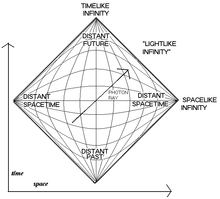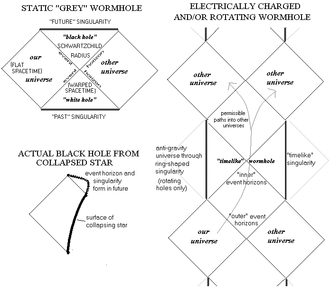- Penrose diagram
-
For the tensor diagram notation, see Penrose graphical notation.
In theoretical physics, a Penrose diagram (named for mathematical physicist Roger Penrose) is a two-dimensional diagram that captures the causal relations between different points in spacetime. It is an extension of a Minkowski diagram where the vertical dimension represents time, and the horizontal dimension represents space, and slanted lines at an angle of 45° correspond to light rays. The biggest difference is that locally, the metric on a Penrose diagram is conformally equivalent to the actual metric in spacetime. The conformal factor is chosen such that the entire infinite spacetime is transformed into a Penrose diagram of finite size. For spherically symmetric spacetimes, every point in the diagram corresponds to a 2-sphere.
Contents
Basic properties
While Penrose diagrams share the same basic coordinate vector system of other space-time diagrams for local asymptotically flat spacetime, it introduces a system of representing distant spacetime by shrinking or "crunching" distances that are further away. Straight lines of constant time and space coordinates therefore become hyperbolas, which appear to converge at points in the corners of the diagram. These points represent "conformal infinity" for space and time.
Penrose diagrams are more properly (but less frequently) called Penrose-Carter diagrams (or Carter-Penrose diagrams), acknowledging both Brandon Carter and Roger Penrose, who were the first researchers to employ them. They are also called conformal diagrams, or simply spacetime diagrams.
Penrose diagram of an infinite Minkowski universe, horizontal axis u, vertical axis v
Two lines drawn at 45° angles should intersect in the diagram only if the corresponding two light rays intersect in the actual spacetime. So, a Penrose diagram can be used as a concise illustration of spacetime regions that are accessible to observation. The diagonal boundary lines of a Penrose diagram correspond to the "infinity" or to singularities where light rays must end. Thus, Penrose diagrams are also useful in the study of asymptotic properties of spacetimes and singularities. An infinite static Minkowski universe, coordinates (x,t) is related to Penrose coordinates (u,v) by:
The corners of the Penrose diamond, which represent the spacelike and timelike conformal infinities, are π / 2 from the origin.
Black holes
Penrose diagrams are frequently used to illustrate the space-time environment of black holes. Singularities are denoted by a spacelike boundary, unlike the timelike boundary found on conventional space-time diagrams. This is due to the interchanging of timelike and spacelike coordinates within the horizon of a black hole (since space is uni-directional within the horizon, just as time is uni-directional outside the horizon). The singularity is represented by a spacelike boundary to make it clear that once an object has passed the horizon it will inevitably hit the singularity even if it attempts to take evasive action.
Penrose diagrams are also used to illustrate the space-time environment of a hypothetical wormhole connecting two separate universes, which is an extension of the Schwarzschild solution of black holes. The precursors to the Penrose diagrams were Kruskal-Szekeres diagrams. These introduced the method of aligning the event horizon into past and future horizons oriented at 45° angles (since one would need to travel faster than light to cross from the Schwarzschild radius back into flat spacetime); and splitting the singularity into past and future horizontally-oriented lines (since the singularity "cuts off" all paths into the future once one enters the hole). The result is a hypothetical object called a grey hole, which is basically a white hole that turns into a black hole after briefly opening up into a wormhole connecting the two asymptotically flat space-time regions called "universes". The wormhole closes off (forming "future" singularities) so rapidly that passage between the two universes would require faster-than-light velocity, and is therefore impossible. The Penrose diagram simply added to Kruskal and Szekeres' diagram the conformal crunching of the regions of flat space-time far from the hole.
While the basic space-like passage of a static black hole cannot be traversed, Penrose diagrams for rotating and/or electrically charged black holes reveal "inner event horizons" (lying in the future) and vertically oriented singularities, which open up what is known as a "time-like wormhole" allowing passage into future universes. In the case of the rotating hole, there is also a "negative gravity" universe entered through a ring-shaped singularity (still portrayed as a line in the diagram) that can be passed through if entering the hole close to its axis of rotation.
With all of this hypothesis regarding wormholes, some scientists have pointed out that
1) This does not describe a typical black hole created from the collapse of a star (which cuts off the past-oriented "white hole" geometry and other universe). Such wormholes would only be possible if a "past singularity" (such as a remnant of the original Big Bang singularity that remained compact) continued erupting into the universe as time went on.
2) The radiation of orbiting, highly blue-shifted light rays surrounding a black hole (called a "blue sheet") would make it impossible for anyone to pass through, and in fact might create another kind of singularity outside the hole!
See also
References
- d'Inverno, Ray (1992). Introducing Einstein's Relativity. Oxford: Oxford University Press. ISBN 0-19-859686-3. See Chapter 17 (and various succeeding sections) for a very readable introduction to the concept of conformal infinity plus examples.
- Frauendiener, Jörg. "Conformal Infinity". Living Reviews in Relativity. http://relativity.livingreviews.org/Articles/lrr-2004-1/index.html. Retrieved February 2, 2004.
- Carter, Brandon (1966). "Complete Analytic Extension of the Symmetry Axis of Kerr's Solution of Einstein's Equations". Phys. Rev. 141 (4): 1242–1247. Bibcode 1966PhRv..141.1242C. doi:10.1103/PhysRev.141.1242. See also on-line version (requires a subscription to access)
- Hawking, Stephen; and Ellis, G. F. R. (1973). The Large Scale Structure of Space-Time. Cambridge: Cambridge University Press. ISBN 0-521-09906-4. See Chapter 5 for a very clear discussion of Penrose diagrams (the term used by Hawking & Ellis) with many examples.
- Kaufmann, William J. III (1977). The Cosmic Frontiers of General Relativity. Little Brown & Co. ISBN 0-316-48341-9. Really breaks down the transition from simple Minkowski diagrams, to Kruskal-Szekeres diagrams to Penrose diagrams, and goes into much detail the facts and fiction concerning wormholes. Plenty of easy to understand illustrations. A less involved, but still very informative book is his William J. Kaufmann (1979)). Black Holes and Warped Spacetime. W H Freeman & Co (Sd). ISBN 0-7167-1153-2.
Categories:- Diagrams
- Mathematical methods in general relativity
- Lorentzian manifolds
Wikimedia Foundation. 2010.



